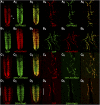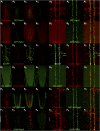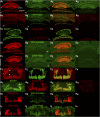Conditional Synaptic Vesicle Markers for Drosophila
- PMID: 30635441
- PMCID: PMC6404611
- DOI: 10.1534/g3.118.200975
Conditional Synaptic Vesicle Markers for Drosophila
Abstract
The release of neurotransmitters from synaptic vesicles (SVs) at pre-synaptic release sites is the principle means by which information transfer between neurons occurs. Knowledge of the location of SVs within a neuron can thus provide valuable clues about the location of neurotransmitter release within a neuron and the downstream neurons to which a given neuron is connected, important information for understanding how neural circuits generate behavior. Here the development and characterization of four conditional tagged SV markers for Drosophila melanogaster is presented. This characterization includes evaluation of conditionality, specificity for SV localization, and sensitivity of detection in diverse neuron subtypes. These four SV markers are genome-edited variants of the synaptic vesicle-specific protein Rab3. They depend on either the B2 or FLP recombinases for conditionality, and incorporate GFP or mCherry fluorescent proteins, or FLAG or HA epitope tags, for detection.
Keywords: Drosophila; conditional; epitope; fluorescent; synaptic vesicle.
Copyright © 2019 Williams et al.
Figures






Similar articles
-
Demonstration of a Simple Epitope Tag Multimerization Strategy for Enhancing the Sensitivity of Protein Detection Using Drosophila vAChT.G3 (Bethesda). 2020 Feb 6;10(2):495-504. doi: 10.1534/g3.119.400750. G3 (Bethesda). 2020. PMID: 31767639 Free PMC article.
-
A conditional glutamatergic synaptic vesicle marker for Drosophila.G3 (Bethesda). 2022 Mar 4;12(3):jkab453. doi: 10.1093/g3journal/jkab453. G3 (Bethesda). 2022. PMID: 35100385 Free PMC article.
-
A conditional GABAergic synaptic vesicle marker for Drosophila.J Neurosci Methods. 2022 Apr 15;372:109540. doi: 10.1016/j.jneumeth.2022.109540. Epub 2022 Feb 24. J Neurosci Methods. 2022. PMID: 35219770 Free PMC article.
-
Synaptic vesicle pools and plasticity of synaptic transmission at the Drosophila synapse.Brain Res Brain Res Rev. 2004 Dec;47(1-3):18-32. doi: 10.1016/j.brainresrev.2004.05.004. Brain Res Brain Res Rev. 2004. PMID: 15572160 Review.
-
Two synaptic vesicle pools, vesicle recruitment and replenishment of pools at the Drosophila neuromuscular junction.J Neurocytol. 2003 Jun-Sep;32(5-8):551-65. doi: 10.1023/B:NEUR.0000020610.13554.3c. J Neurocytol. 2003. PMID: 15034253 Review.
Cited by
-
Identification of Split-GAL4 Drivers and Enhancers That Allow Regional Cell Type Manipulations of the Drosophila melanogaster Intestine.Genetics. 2020 Dec;216(4):891-903. doi: 10.1534/genetics.120.303625. Epub 2020 Sep 28. Genetics. 2020. PMID: 32988987 Free PMC article.
-
SynLight: a bicistronic strategy for simultaneous active zone and cell labeling in the Drosophila nervous system.G3 (Bethesda). 2023 Nov 1;13(11):jkad221. doi: 10.1093/g3journal/jkad221. G3 (Bethesda). 2023. PMID: 37757863 Free PMC article.
-
Demonstration of a Simple Epitope Tag Multimerization Strategy for Enhancing the Sensitivity of Protein Detection Using Drosophila vAChT.G3 (Bethesda). 2020 Feb 6;10(2):495-504. doi: 10.1534/g3.119.400750. G3 (Bethesda). 2020. PMID: 31767639 Free PMC article.
-
Redesigning the Drosophila histone gene cluster: an improved genetic platform for spatiotemporal manipulation of histone function.Genetics. 2024 Sep 4;228(1):iyae117. doi: 10.1093/genetics/iyae117. Genetics. 2024. PMID: 39039029 Free PMC article.
-
A conditional glutamatergic synaptic vesicle marker for Drosophila.G3 (Bethesda). 2022 Mar 4;12(3):jkab453. doi: 10.1093/g3journal/jkab453. G3 (Bethesda). 2022. PMID: 35100385 Free PMC article.
References
Publication types
MeSH terms
Substances
Associated data
Grants and funding
LinkOut - more resources
Full Text Sources
Molecular Biology Databases
Research Materials
